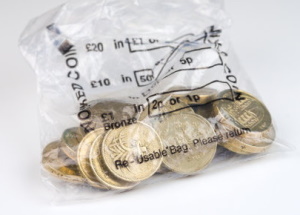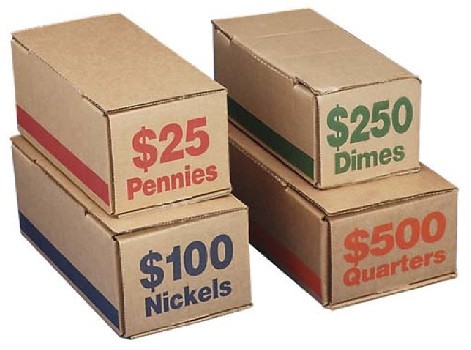How Coins Are Made: Step-by-Step Guide
Have you ever wondered how coins are made? When you think about it, coins are like little pieces of sculptural art, and today’s coins are struck with amazing precision. It's a fascinating process that coin collectors of all ages, adults and kids alike, should be familiar with.
The process of making coins has become very well mechanized and highly systematized over the eons since the first coins were struck thousands of years ago. However, the same basic principles of striking a coin have remained largely the same. It involves stamping a design onto a blank piece of metal by a government that monetizes coins struck under its authority.
The steps we outline below cover the most typical process of striking a coin for circulation in modern times:
Step #1 – Blanking
.jpeg)
Coin blanks look exactly like they sound: blank on both sides.
After metal ore has been mined and refined for coining, it is usually processed into long strips, often several-hundred feet long. It is from this sheet of metal from which the (usually) round discs of metal used for making coins are punched.
This part of the coin-making process is known as blanking. Upon blanking, these little discs of metal are collected and prepared for the next step of production.
Step #2 – Annealing
In the annealing process, the little discs of metal intended to be struck into coins are heated so the metal is more malleable, or softer, so it can be prepared for striking. The blanks are heated in a furnace, attainting temperatures as hit as 1,600 degrees Fahrenheit. They are then quickly cooled in a water-based solution of citric acid powder and lubricants.
Step #3 – Cleaning & Drying
Next, the blanks of metal are washed in a solution of cleaning and anti-tarnishing agents. Then the cleaned blanks are processed through dryer steam.
The blanks are often put through a centrifugal tumbler that is filled with pebble-sized materials to clean off and smooth out any imperfections. The cleaning media can come in different shapes and may be made from different materials, such as ceramic, porcelain, or stainless steel.
Step #4 – Upsetting
.jpeg)
No, the coins aren’t perturbed or disconcerted in the upsetting process! The “upsetting” of a blank refers to the part of the process in which the lip of metal around the perimeter of the blank is raised in preparation of striking the coin.
The lip is raised in the upsetting mill, where blanks are pushed through a groove that is just a bit narrower than the diameter of the disc. It is in this process when a disc of metal intended for coining officially goes from being merely a “blank” to a “planchet.”
Step #5 – Striking
.jpeg)
Prior to the modern period, coins were struck by hand with a hammer and anvil.
Here is where the “magic” really happens… This is where the blank pieces of metal are transformed into legal-tender money!
The exact process and specifications of striking a coin depend on the type of coin being struck, but they are all similar in that they entail the striking of a planchet by the obverse (“heads side”) and reverse (“tails side”) dies.
When this occurs, the planchet is typically harnessed within a collar, which secures the coin in just the right place for striking. This also helps create the rim; in some cases, the collar will be outfitted with grooves to create the reeded edges seen on some coins.
Coins are struck under terrific pressure, with some planchets being pressed between 35 tons and 100 tons of force upon strike. Larger coins, those made from harder metals, or pieces that require a higher relief may be subjected to pressures beyond 500 tons upon strike.
How many coins are made at a time? A single United States Mint coin press will typically produce about 750 coins each minute of operation. And with more than 50 presses at each the Philadelphia and Denver Mint facilities, the U.S. Mint can easily churn out tens of thousands of coins per minute when all the presses are operating at full tilt. In fact, the U.S. Mint annually produces about 10 billion coins each year!
Step #6 – Inspecting
When you’re striking thousands of coins each minute and billions each year, a few mistakes are bound to happen. This is where the inspection process becomes quite important for mint officials.
After coins are struck, they are inspected for unconformities. Coin collectors better know these as errors—something the quality control team at the mint vigorously endeavors to eliminate!
Step #7 – Counting & Distribution

Coins are distributed from mints in rolls or bags.
Coins struck for circulation that have passed muster in the inspection process are then counted and weighed by machines. Then they are moved along the process to bagging.
These bags of coins or boxes of coin rolls will then be shipped off to the various Federal Reserve banks around the country, which then filters the coins into commerce by way of distribution to private financial institutions such as banks and credit unions.
Watch Coins Be Made in Person
Now you know how coins are made… But how would you like to see them get made right before your very eyes? The United States Mint offers public tours at its Philadelphia and Denver Mint facilities.
The Philadelphia Mint tours are free and self-guided, mostly unfolding along an enclosed catwalk that overlooks the minting process down on the production floor; Denver Mint tours generally require a ticket and are guided.

Freshly minted coins are organized in boxes of coin rolls.
It’s fascinating to watch coins actually be made, and you can gain a better appreciation of the process of making coinage once you see it for yourself. There many steps in making coins. Even in this age of automated coin production, there are also many people who help along the way. This includes the designers and engravers who create the hubs and dies to the folks on the production floor who ensure the ultra-modern machines are all doing what they need to. Hopefully you can visit one of the mints someday and watch with your own eyes how coins are made!
Joshua McMorrow-Hernandez is a journalist, editor, and blogger who has won multiple awards from the Numismatic Literary Guild. He has also authored numerous books, including works profiling the history of the United States Mint and United States coinage.
Read more about collecting coins from the expert authors at Gainesville Coins:
Collector Resources for Understanding the Hobby of Collecting Coins
1943 Steel Penny Value: How Much They Are Worth Now
Anatomy of a Coin: How to Identify Coins On Sight
Numismatics Guide: Discover the Thrill of Coin Collecting
How To Clean Oxidized Coins (If You Dare!)
How To Collect Coins For Beginners: Coin Collecting 101
How to Buy Junk Silver Coins: Complete Guide
